Statistics for Business Decisions Report: Analysis and Findings
VerifiedAdded on 2020/12/09
|15
|1897
|239
Report
AI Summary
This report provides a comprehensive analysis of statistical techniques used in business decision-making. It begins with an introduction highlighting the importance of statistical tools in analyzing and interpreting large datasets. The report then delves into various case situations, demonstrating how graphical presentations effectively aid in understanding datasets. Question 1 focuses on graphical techniques for comparing the value and percentage value of Australian exports, providing insights into export trends across different countries. Question 2 covers the construction of frequency and relative frequency distributions, cumulative distributions, histogram plotting, and ogive charts, along with the interpretation of proportions from the data. Question 3 explores descriptive measures for two variables, investigating the relationship between final consumption expenditure and retail turnover per capita. The report includes descriptive statistics, calculation of the coefficient of correlation, regression analysis, and interpretation of the results. The conclusion summarizes the key findings, emphasizing the statistical significance of the relationships between the variables discussed. The report references several books and journals related to statistics and econometrics.
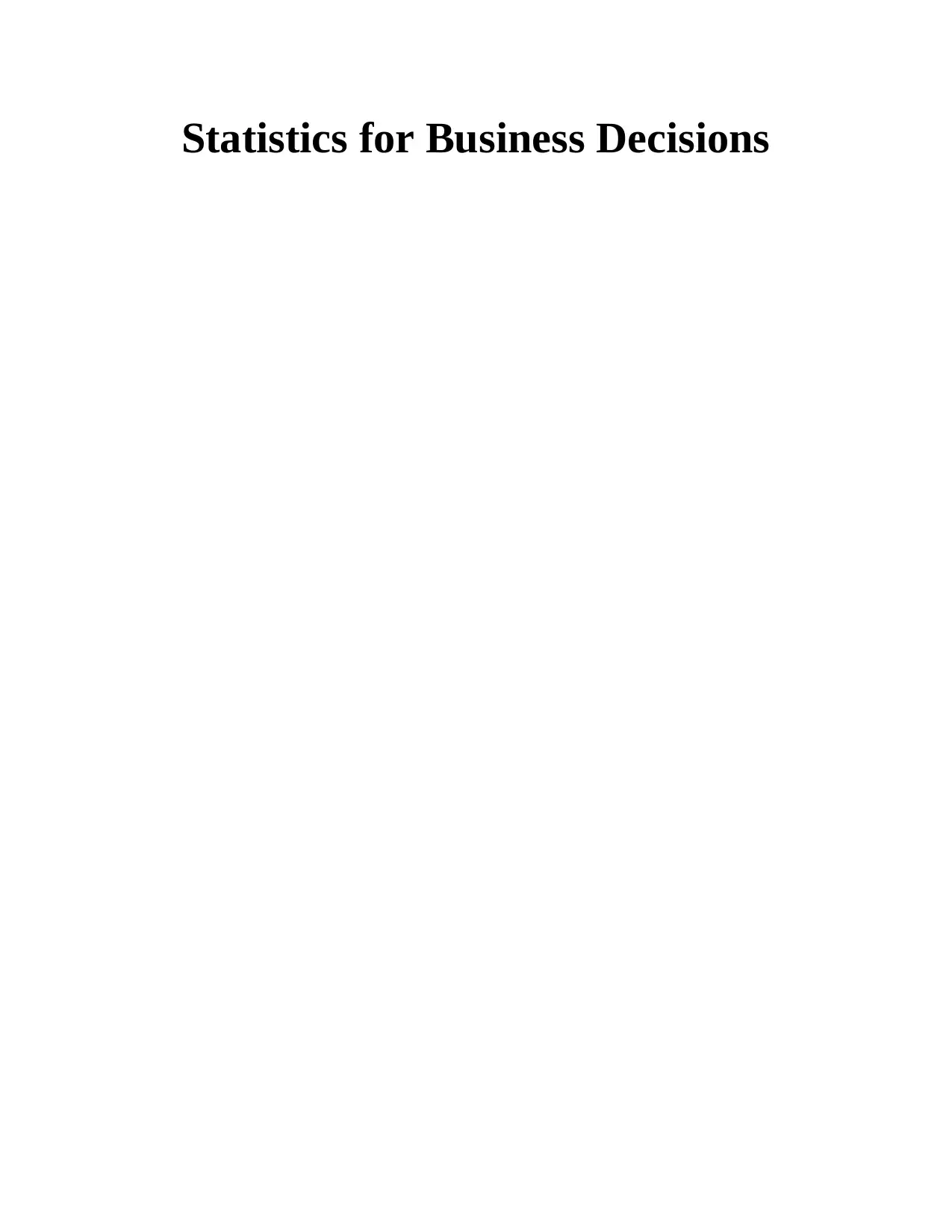
Statistics for Business Decisions
Paraphrase This Document
Need a fresh take? Get an instant paraphrase of this document with our AI Paraphraser
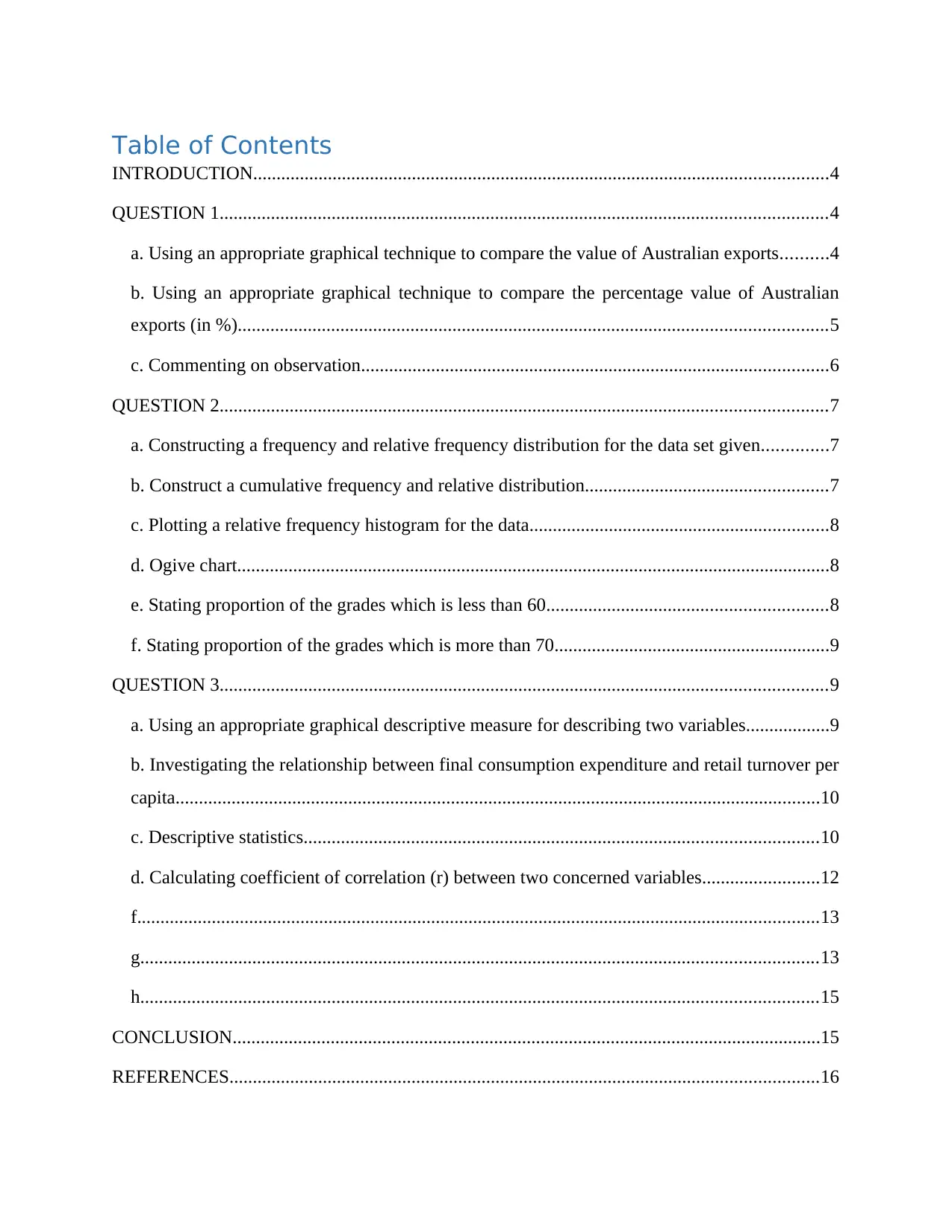
Table of Contents
INTRODUCTION...........................................................................................................................4
QUESTION 1..................................................................................................................................4
a. Using an appropriate graphical technique to compare the value of Australian exports..........4
b. Using an appropriate graphical technique to compare the percentage value of Australian
exports (in %)..............................................................................................................................5
c. Commenting on observation....................................................................................................6
QUESTION 2..................................................................................................................................7
a. Constructing a frequency and relative frequency distribution for the data set given..............7
b. Construct a cumulative frequency and relative distribution....................................................7
c. Plotting a relative frequency histogram for the data................................................................8
d. Ogive chart...............................................................................................................................8
e. Stating proportion of the grades which is less than 60............................................................8
f. Stating proportion of the grades which is more than 70...........................................................9
QUESTION 3..................................................................................................................................9
a. Using an appropriate graphical descriptive measure for describing two variables..................9
b. Investigating the relationship between final consumption expenditure and retail turnover per
capita..........................................................................................................................................10
c. Descriptive statistics..............................................................................................................10
d. Calculating coefficient of correlation (r) between two concerned variables.........................12
f..................................................................................................................................................13
g.................................................................................................................................................13
h.................................................................................................................................................15
CONCLUSION..............................................................................................................................15
REFERENCES..............................................................................................................................16
INTRODUCTION...........................................................................................................................4
QUESTION 1..................................................................................................................................4
a. Using an appropriate graphical technique to compare the value of Australian exports..........4
b. Using an appropriate graphical technique to compare the percentage value of Australian
exports (in %)..............................................................................................................................5
c. Commenting on observation....................................................................................................6
QUESTION 2..................................................................................................................................7
a. Constructing a frequency and relative frequency distribution for the data set given..............7
b. Construct a cumulative frequency and relative distribution....................................................7
c. Plotting a relative frequency histogram for the data................................................................8
d. Ogive chart...............................................................................................................................8
e. Stating proportion of the grades which is less than 60............................................................8
f. Stating proportion of the grades which is more than 70...........................................................9
QUESTION 3..................................................................................................................................9
a. Using an appropriate graphical descriptive measure for describing two variables..................9
b. Investigating the relationship between final consumption expenditure and retail turnover per
capita..........................................................................................................................................10
c. Descriptive statistics..............................................................................................................10
d. Calculating coefficient of correlation (r) between two concerned variables.........................12
f..................................................................................................................................................13
g.................................................................................................................................................13
h.................................................................................................................................................15
CONCLUSION..............................................................................................................................15
REFERENCES..............................................................................................................................16
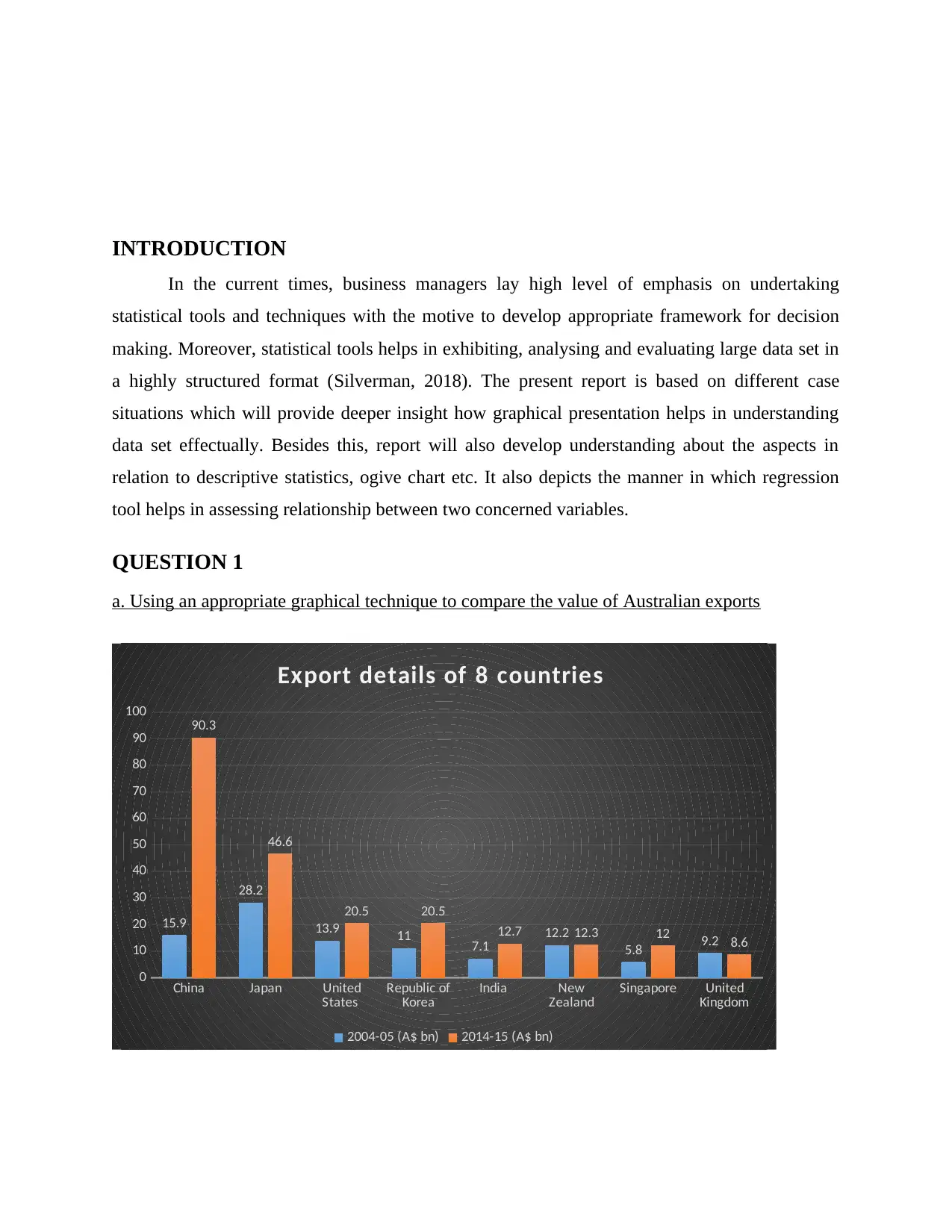
INTRODUCTION
In the current times, business managers lay high level of emphasis on undertaking
statistical tools and techniques with the motive to develop appropriate framework for decision
making. Moreover, statistical tools helps in exhibiting, analysing and evaluating large data set in
a highly structured format (Silverman, 2018). The present report is based on different case
situations which will provide deeper insight how graphical presentation helps in understanding
data set effectually. Besides this, report will also develop understanding about the aspects in
relation to descriptive statistics, ogive chart etc. It also depicts the manner in which regression
tool helps in assessing relationship between two concerned variables.
QUESTION 1
a. Using an appropriate graphical technique to compare the value of Australian exports
China Japan United
States Republic of
Korea India New
Zealand Singapore United
Kingdom
0
10
20
30
40
50
60
70
80
90
100
15.9
28.2
13.9 11 7.1 12.2
5.8 9.2
90.3
46.6
20.5 20.5
12.7 12.3 12 8.6
Export details of 8 countries
2004-05 (A$ bn) 2014-15 (A$ bn)
In the current times, business managers lay high level of emphasis on undertaking
statistical tools and techniques with the motive to develop appropriate framework for decision
making. Moreover, statistical tools helps in exhibiting, analysing and evaluating large data set in
a highly structured format (Silverman, 2018). The present report is based on different case
situations which will provide deeper insight how graphical presentation helps in understanding
data set effectually. Besides this, report will also develop understanding about the aspects in
relation to descriptive statistics, ogive chart etc. It also depicts the manner in which regression
tool helps in assessing relationship between two concerned variables.
QUESTION 1
a. Using an appropriate graphical technique to compare the value of Australian exports
China Japan United
States Republic of
Korea India New
Zealand Singapore United
Kingdom
0
10
20
30
40
50
60
70
80
90
100
15.9
28.2
13.9 11 7.1 12.2
5.8 9.2
90.3
46.6
20.5 20.5
12.7 12.3 12 8.6
Export details of 8 countries
2004-05 (A$ bn) 2014-15 (A$ bn)
⊘ This is a preview!⊘
Do you want full access?
Subscribe today to unlock all pages.

Trusted by 1+ million students worldwide
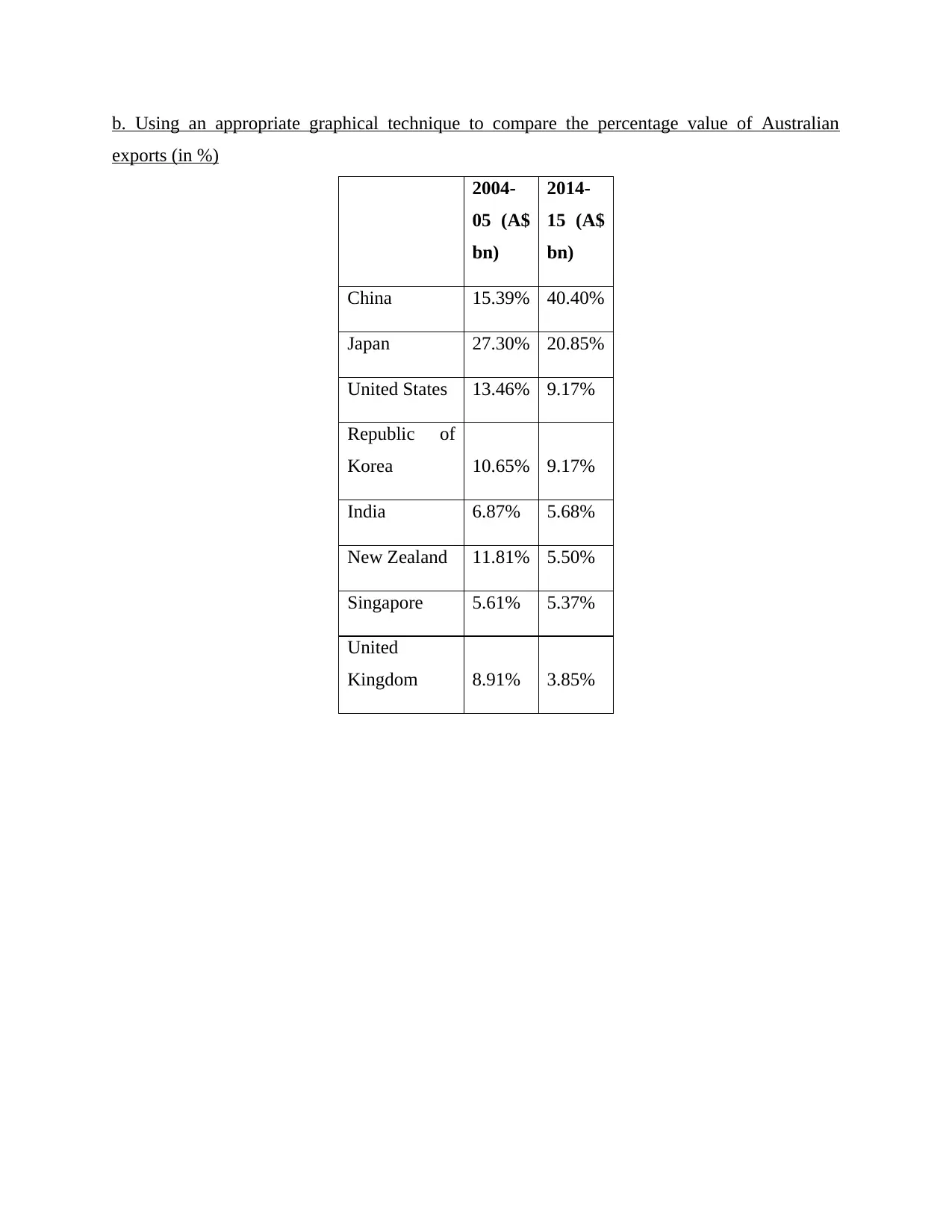
b. Using an appropriate graphical technique to compare the percentage value of Australian
exports (in %)
2004-
05 (A$
bn)
2014-
15 (A$
bn)
China 15.39% 40.40%
Japan 27.30% 20.85%
United States 13.46% 9.17%
Republic of
Korea 10.65% 9.17%
India 6.87% 5.68%
New Zealand 11.81% 5.50%
Singapore 5.61% 5.37%
United
Kingdom 8.91% 3.85%
exports (in %)
2004-
05 (A$
bn)
2014-
15 (A$
bn)
China 15.39% 40.40%
Japan 27.30% 20.85%
United States 13.46% 9.17%
Republic of
Korea 10.65% 9.17%
India 6.87% 5.68%
New Zealand 11.81% 5.50%
Singapore 5.61% 5.37%
United
Kingdom 8.91% 3.85%
Paraphrase This Document
Need a fresh take? Get an instant paraphrase of this document with our AI Paraphraser

China Japan United States Republic of
Korea India New Zealand Singapore United
Kingdom
0.00%
5.00%
10.00%
15.00%
20.00%
25.00%
30.00%
35.00%
40.00%
45.00%
15.39%
27.30%
13.46%
10.65%
6.87%
11.81%
5.61%
8.91%
40.40%
20.85%
9.17% 9.17%
5.68% 5.50% 5.37% 3.85%
Export details of 8 countries
(in %)
2004-05 (A$ bn) 2014-15 (A$ bn)
c. Commenting on observation
From the above graphical analysis (graph A) it has been assessed that the value of the
export of Australian product has been increased over the years from 2004-05 to 2014-15. This
means that the demand of the product over the years has been increased which in turn shows an
improved performance of the companies in the overall economy of the Australian country. In
china and Japan exports has been increased with higher value while in the other 6 countries the
export has remained stable and increasing.
It has been observed from graphical presentation (b) that the export made by the Australia
in different countries in the year 2004-05 and during the year 2014-15 has shown a decreasing
trend in most of the countries. The resulting export of the Australia has shown high percentage
increase in the China from 2004-05 to 2014-15. This indicates that the demand for the Australian
products has been rising in china with a greater value which in turn increases in the growth of the
country as higher profitability has been generated in within the economy of the Australia. In all
the other countries that includes Japan, United States, India, Korea, New Zealand, Singapore,
UK is showing a declining results in 2014-15, which reflects that the demand for the Australian
products has been reduced. This results downfall in the earning of the companies in the overall
economy.
Korea India New Zealand Singapore United
Kingdom
0.00%
5.00%
10.00%
15.00%
20.00%
25.00%
30.00%
35.00%
40.00%
45.00%
15.39%
27.30%
13.46%
10.65%
6.87%
11.81%
5.61%
8.91%
40.40%
20.85%
9.17% 9.17%
5.68% 5.50% 5.37% 3.85%
Export details of 8 countries
(in %)
2004-05 (A$ bn) 2014-15 (A$ bn)
c. Commenting on observation
From the above graphical analysis (graph A) it has been assessed that the value of the
export of Australian product has been increased over the years from 2004-05 to 2014-15. This
means that the demand of the product over the years has been increased which in turn shows an
improved performance of the companies in the overall economy of the Australian country. In
china and Japan exports has been increased with higher value while in the other 6 countries the
export has remained stable and increasing.
It has been observed from graphical presentation (b) that the export made by the Australia
in different countries in the year 2004-05 and during the year 2014-15 has shown a decreasing
trend in most of the countries. The resulting export of the Australia has shown high percentage
increase in the China from 2004-05 to 2014-15. This indicates that the demand for the Australian
products has been rising in china with a greater value which in turn increases in the growth of the
country as higher profitability has been generated in within the economy of the Australia. In all
the other countries that includes Japan, United States, India, Korea, New Zealand, Singapore,
UK is showing a declining results in 2014-15, which reflects that the demand for the Australian
products has been reduced. This results downfall in the earning of the companies in the overall
economy.
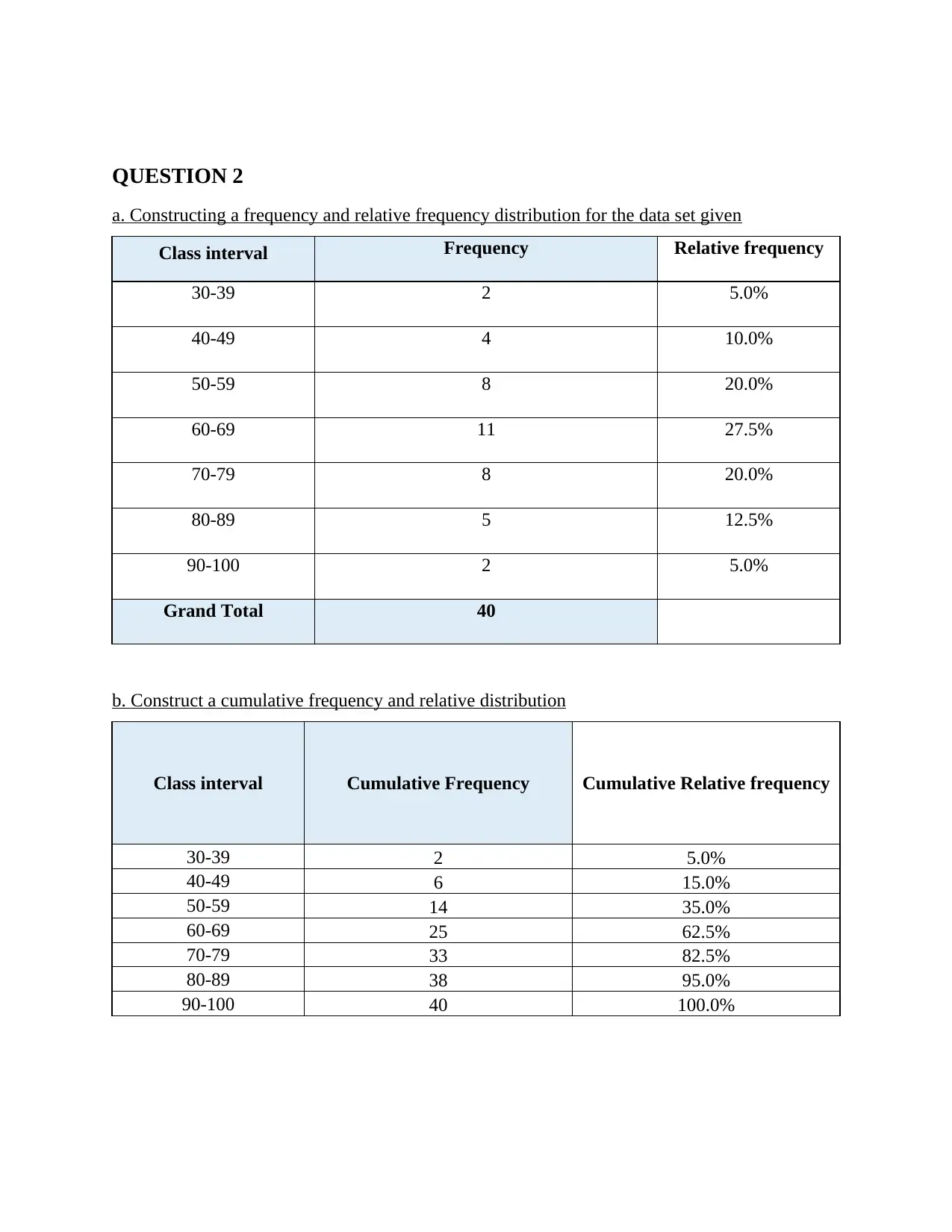
QUESTION 2
a. Constructing a frequency and relative frequency distribution for the data set given
Class interval Frequency Relative frequency
30-39 2 5.0%
40-49 4 10.0%
50-59 8 20.0%
60-69 11 27.5%
70-79 8 20.0%
80-89 5 12.5%
90-100 2 5.0%
Grand Total 40
b. Construct a cumulative frequency and relative distribution
Class interval Cumulative Frequency Cumulative Relative frequency
30-39 2 5.0%
40-49 6 15.0%
50-59 14 35.0%
60-69 25 62.5%
70-79 33 82.5%
80-89 38 95.0%
90-100 40 100.0%
a. Constructing a frequency and relative frequency distribution for the data set given
Class interval Frequency Relative frequency
30-39 2 5.0%
40-49 4 10.0%
50-59 8 20.0%
60-69 11 27.5%
70-79 8 20.0%
80-89 5 12.5%
90-100 2 5.0%
Grand Total 40
b. Construct a cumulative frequency and relative distribution
Class interval Cumulative Frequency Cumulative Relative frequency
30-39 2 5.0%
40-49 6 15.0%
50-59 14 35.0%
60-69 25 62.5%
70-79 33 82.5%
80-89 38 95.0%
90-100 40 100.0%
⊘ This is a preview!⊘
Do you want full access?
Subscribe today to unlock all pages.

Trusted by 1+ million students worldwide
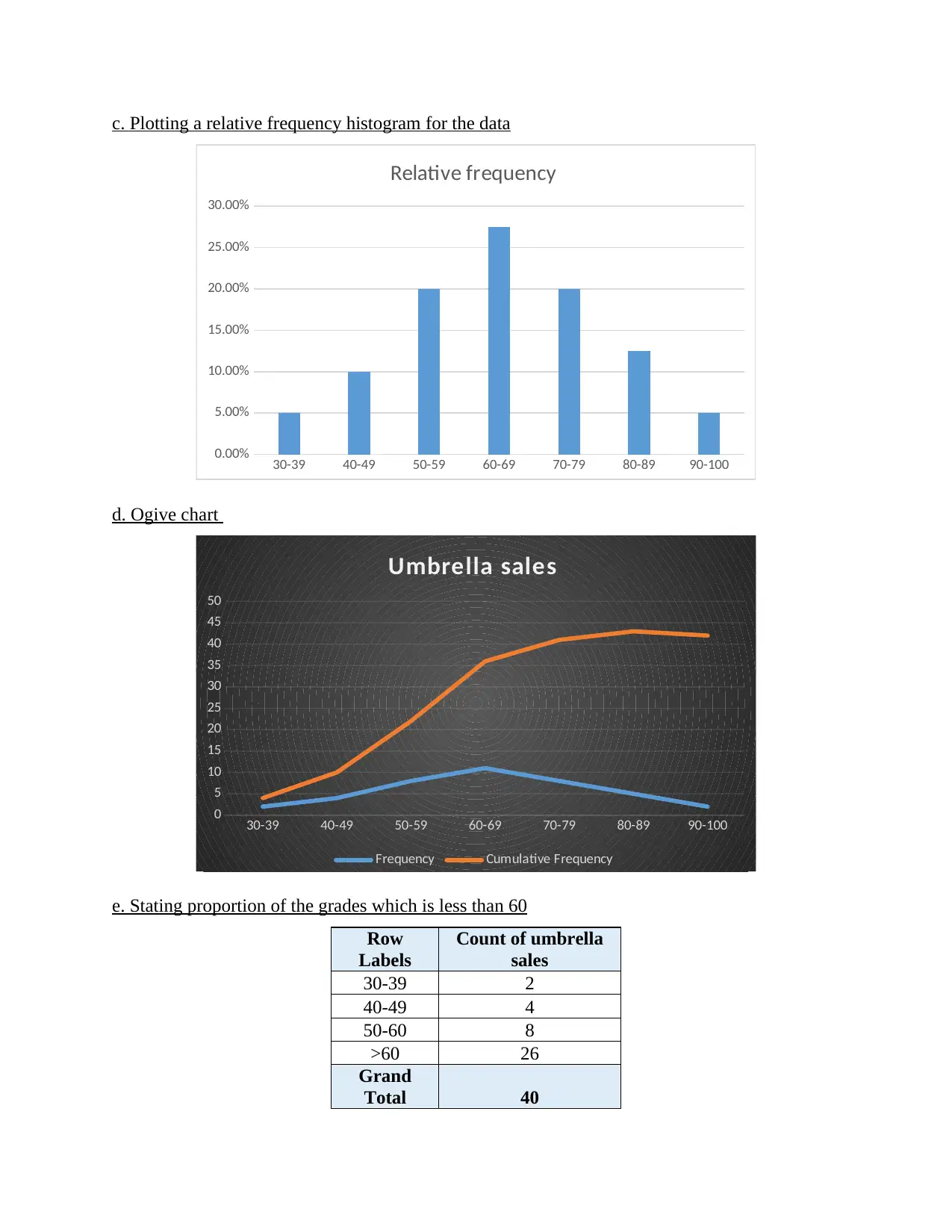
c. Plotting a relative frequency histogram for the data
30-39 40-49 50-59 60-69 70-79 80-89 90-100
0.00%
5.00%
10.00%
15.00%
20.00%
25.00%
30.00%
Relative frequency
d. Ogive chart
30-39 40-49 50-59 60-69 70-79 80-89 90-100
0
5
10
15
20
25
30
35
40
45
50
Umbrella sales
Frequency Cumulative Frequency
e. Stating proportion of the grades which is less than 60
Row
Labels
Count of umbrella
sales
30-39 2
40-49 4
50-60 8
>60 26
Grand
Total 40
30-39 40-49 50-59 60-69 70-79 80-89 90-100
0.00%
5.00%
10.00%
15.00%
20.00%
25.00%
30.00%
Relative frequency
d. Ogive chart
30-39 40-49 50-59 60-69 70-79 80-89 90-100
0
5
10
15
20
25
30
35
40
45
50
Umbrella sales
Frequency Cumulative Frequency
e. Stating proportion of the grades which is less than 60
Row
Labels
Count of umbrella
sales
30-39 2
40-49 4
50-60 8
>60 26
Grand
Total 40
Paraphrase This Document
Need a fresh take? Get an instant paraphrase of this document with our AI Paraphraser
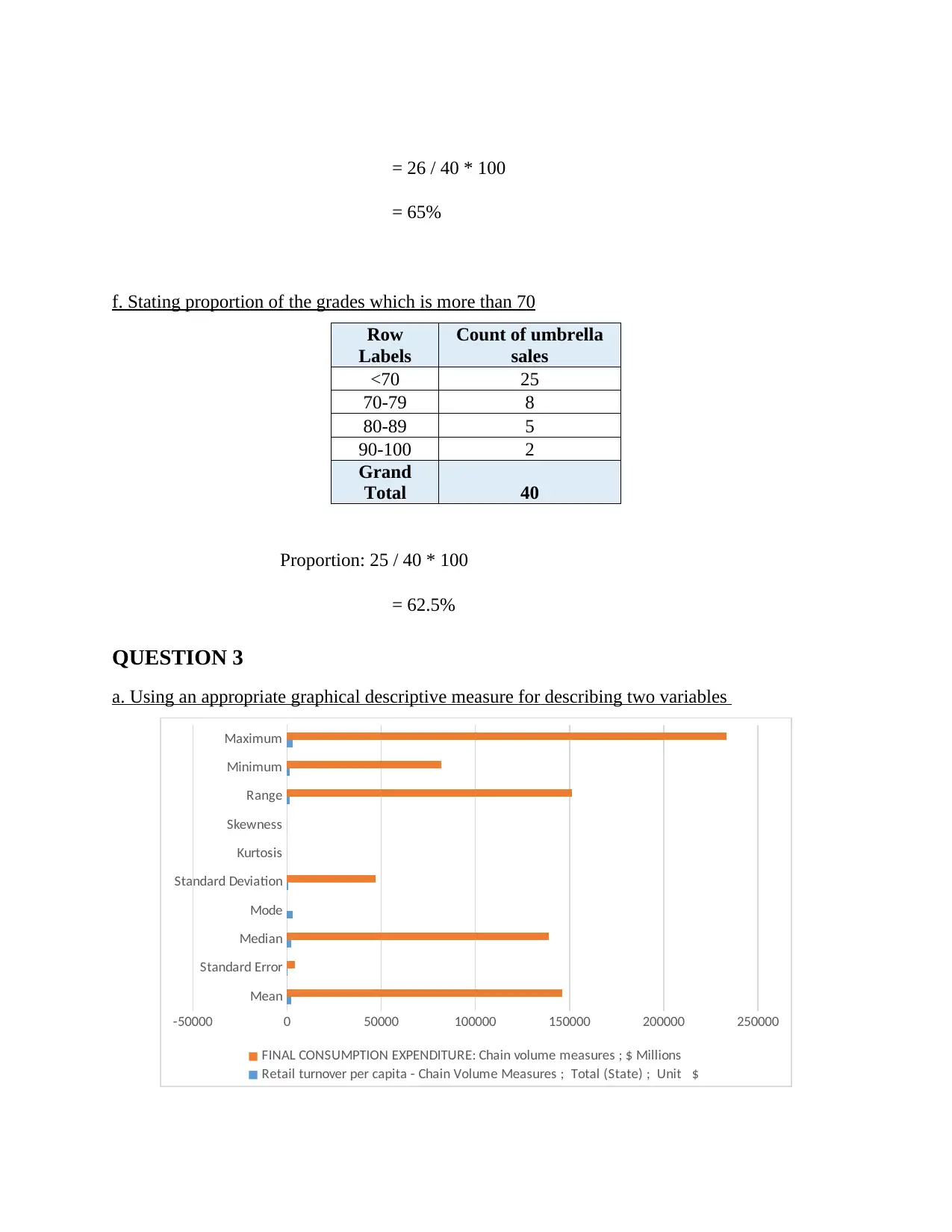
= 26 / 40 * 100
= 65%
f. Stating proportion of the grades which is more than 70
Row
Labels
Count of umbrella
sales
<70 25
70-79 8
80-89 5
90-100 2
Grand
Total 40
Proportion: 25 / 40 * 100
= 62.5%
QUESTION 3
a. Using an appropriate graphical descriptive measure for describing two variables
Mean
Standard Error
Median
Mode
Standard Deviation
Kurtosis
Skewness
Range
Minimum
Maximum
-50000 0 50000 100000 150000 200000 250000
FINAL CONSUMPTION EXPENDITURE: Chain volume measures ; $ Millions
Retail turnover per capita - Chain Volume Measures ; Total (State) ; Unit $
= 65%
f. Stating proportion of the grades which is more than 70
Row
Labels
Count of umbrella
sales
<70 25
70-79 8
80-89 5
90-100 2
Grand
Total 40
Proportion: 25 / 40 * 100
= 62.5%
QUESTION 3
a. Using an appropriate graphical descriptive measure for describing two variables
Mean
Standard Error
Median
Mode
Standard Deviation
Kurtosis
Skewness
Range
Minimum
Maximum
-50000 0 50000 100000 150000 200000 250000
FINAL CONSUMPTION EXPENDITURE: Chain volume measures ; $ Millions
Retail turnover per capita - Chain Volume Measures ; Total (State) ; Unit $
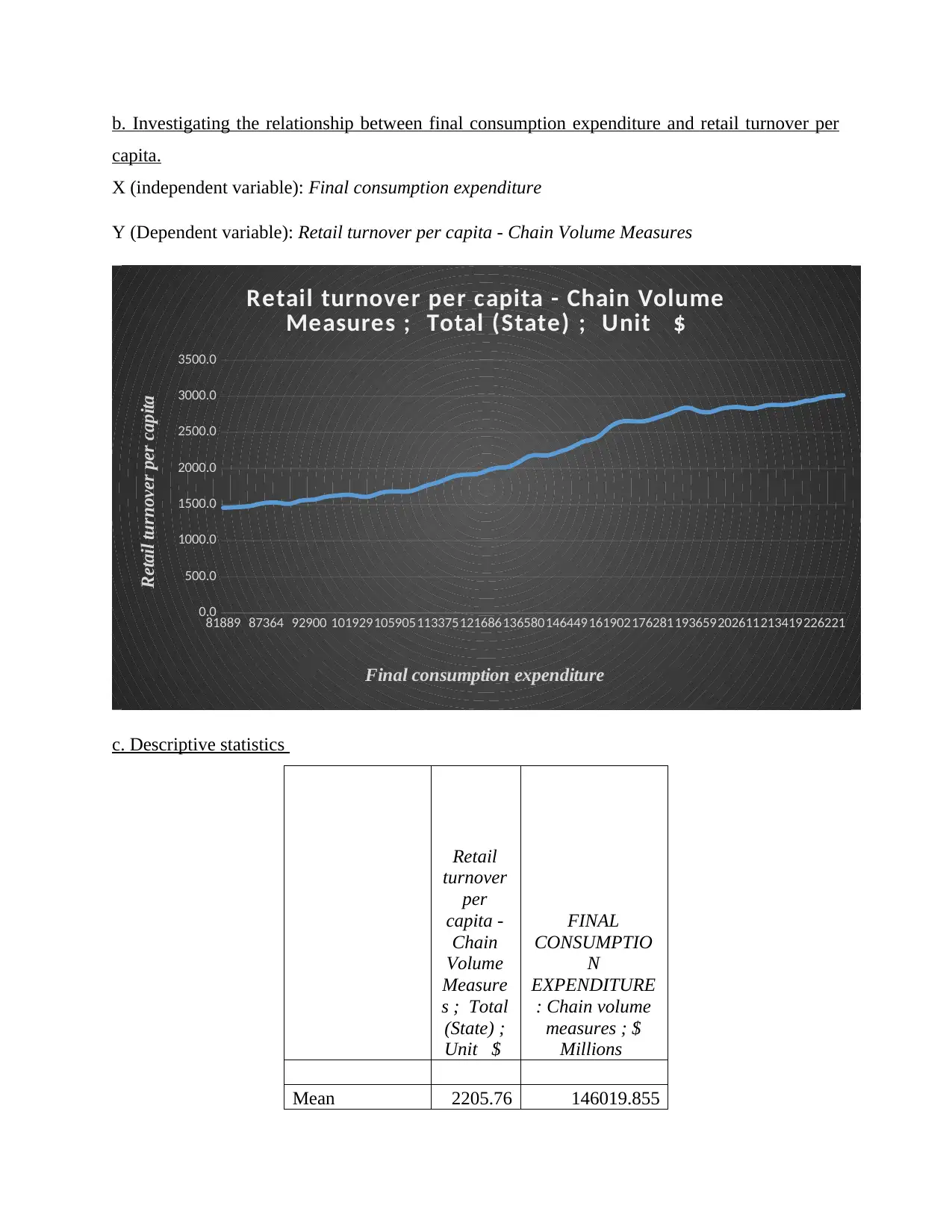
b. Investigating the relationship between final consumption expenditure and retail turnover per
capita.
X (independent variable): Final consumption expenditure
Y (Dependent variable): Retail turnover per capita - Chain Volume Measures
81889 87364 92900 101929105905113375121686136580146449161902176281193659202611213419226221
0.0
500.0
1000.0
1500.0
2000.0
2500.0
3000.0
3500.0
Retail turnover per capita - Chain Volume
Measures ; Total (State) ; Unit $
Final consumption expenditure
Retail turnover per capita
c. Descriptive statistics
Retail
turnover
per
capita -
Chain
Volume
Measure
s ; Total
(State) ;
Unit $
FINAL
CONSUMPTIO
N
EXPENDITURE
: Chain volume
measures ; $
Millions
Mean 2205.76 146019.855
capita.
X (independent variable): Final consumption expenditure
Y (Dependent variable): Retail turnover per capita - Chain Volume Measures
81889 87364 92900 101929105905113375121686136580146449161902176281193659202611213419226221
0.0
500.0
1000.0
1500.0
2000.0
2500.0
3000.0
3500.0
Retail turnover per capita - Chain Volume
Measures ; Total (State) ; Unit $
Final consumption expenditure
Retail turnover per capita
c. Descriptive statistics
Retail
turnover
per
capita -
Chain
Volume
Measure
s ; Total
(State) ;
Unit $
FINAL
CONSUMPTIO
N
EXPENDITURE
: Chain volume
measures ; $
Millions
Mean 2205.76 146019.855
⊘ This is a preview!⊘
Do you want full access?
Subscribe today to unlock all pages.

Trusted by 1+ million students worldwide
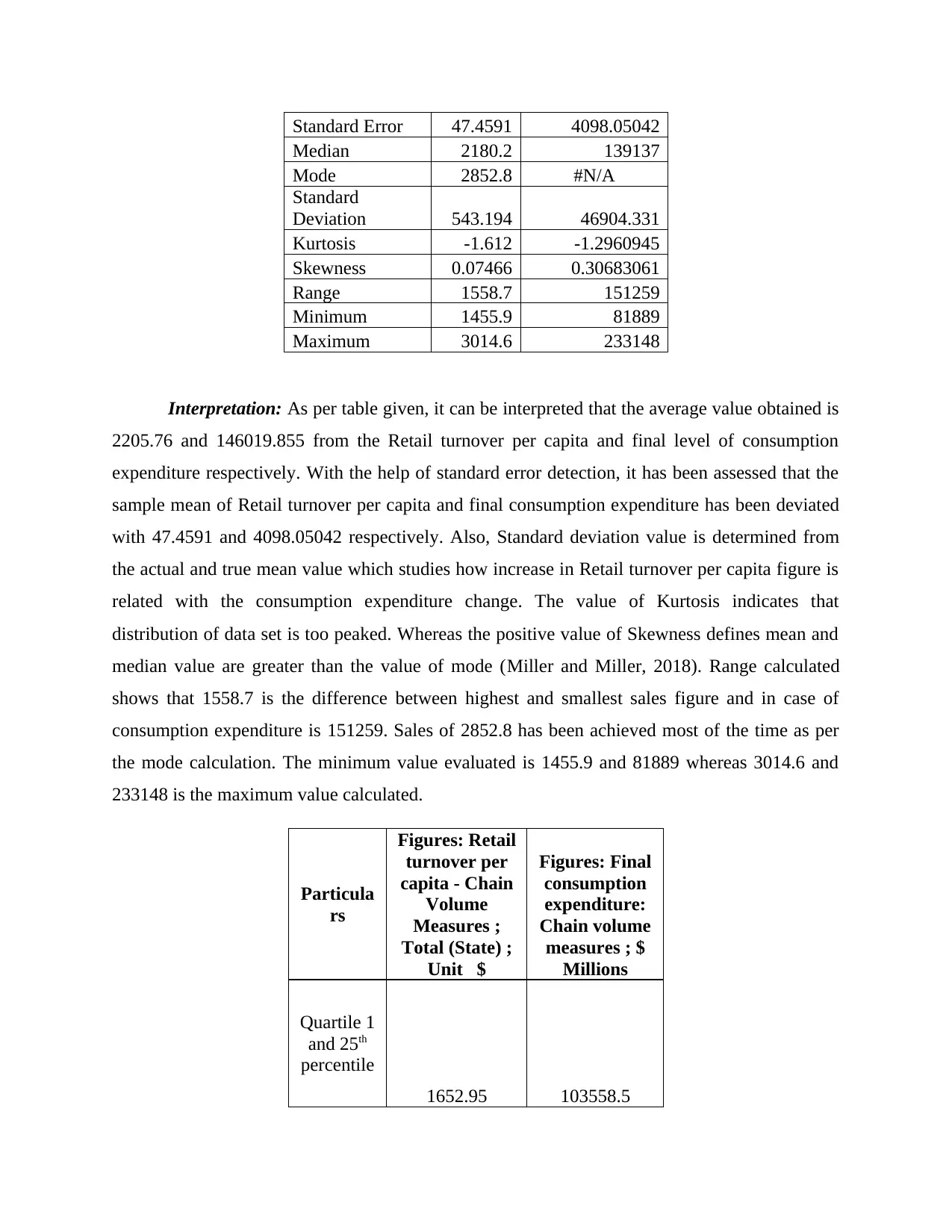
Standard Error 47.4591 4098.05042
Median 2180.2 139137
Mode 2852.8 #N/A
Standard
Deviation 543.194 46904.331
Kurtosis -1.612 -1.2960945
Skewness 0.07466 0.30683061
Range 1558.7 151259
Minimum 1455.9 81889
Maximum 3014.6 233148
Interpretation: As per table given, it can be interpreted that the average value obtained is
2205.76 and 146019.855 from the Retail turnover per capita and final level of consumption
expenditure respectively. With the help of standard error detection, it has been assessed that the
sample mean of Retail turnover per capita and final consumption expenditure has been deviated
with 47.4591 and 4098.05042 respectively. Also, Standard deviation value is determined from
the actual and true mean value which studies how increase in Retail turnover per capita figure is
related with the consumption expenditure change. The value of Kurtosis indicates that
distribution of data set is too peaked. Whereas the positive value of Skewness defines mean and
median value are greater than the value of mode (Miller and Miller, 2018). Range calculated
shows that 1558.7 is the difference between highest and smallest sales figure and in case of
consumption expenditure is 151259. Sales of 2852.8 has been achieved most of the time as per
the mode calculation. The minimum value evaluated is 1455.9 and 81889 whereas 3014.6 and
233148 is the maximum value calculated.
Particula
rs
Figures: Retail
turnover per
capita - Chain
Volume
Measures ;
Total (State) ;
Unit $
Figures: Final
consumption
expenditure:
Chain volume
measures ; $
Millions
Quartile 1
and 25th
percentile
1652.95 103558.5
Median 2180.2 139137
Mode 2852.8 #N/A
Standard
Deviation 543.194 46904.331
Kurtosis -1.612 -1.2960945
Skewness 0.07466 0.30683061
Range 1558.7 151259
Minimum 1455.9 81889
Maximum 3014.6 233148
Interpretation: As per table given, it can be interpreted that the average value obtained is
2205.76 and 146019.855 from the Retail turnover per capita and final level of consumption
expenditure respectively. With the help of standard error detection, it has been assessed that the
sample mean of Retail turnover per capita and final consumption expenditure has been deviated
with 47.4591 and 4098.05042 respectively. Also, Standard deviation value is determined from
the actual and true mean value which studies how increase in Retail turnover per capita figure is
related with the consumption expenditure change. The value of Kurtosis indicates that
distribution of data set is too peaked. Whereas the positive value of Skewness defines mean and
median value are greater than the value of mode (Miller and Miller, 2018). Range calculated
shows that 1558.7 is the difference between highest and smallest sales figure and in case of
consumption expenditure is 151259. Sales of 2852.8 has been achieved most of the time as per
the mode calculation. The minimum value evaluated is 1455.9 and 81889 whereas 3014.6 and
233148 is the maximum value calculated.
Particula
rs
Figures: Retail
turnover per
capita - Chain
Volume
Measures ;
Total (State) ;
Unit $
Figures: Final
consumption
expenditure:
Chain volume
measures ; $
Millions
Quartile 1
and 25th
percentile
1652.95 103558.5
Paraphrase This Document
Need a fresh take? Get an instant paraphrase of this document with our AI Paraphraser
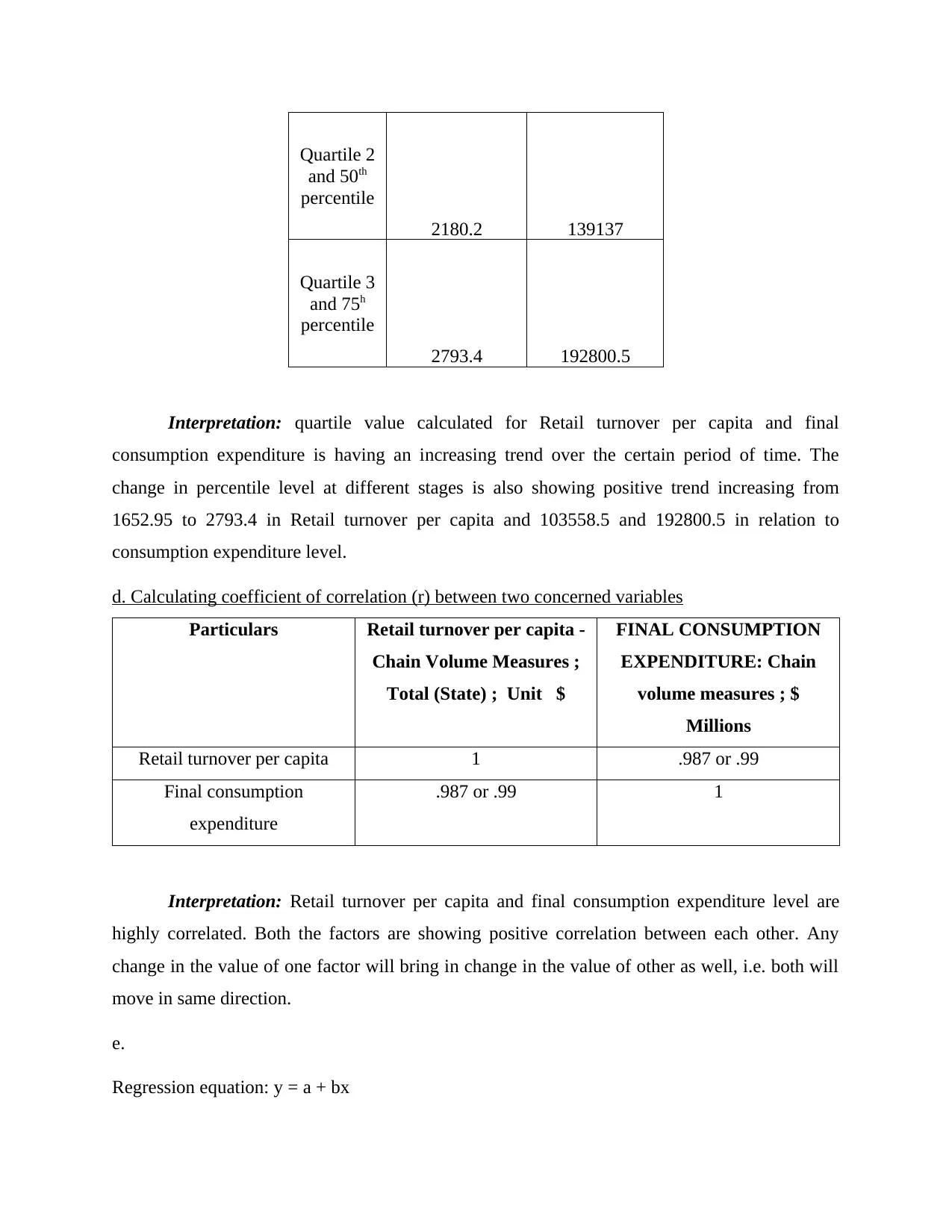
Quartile 2
and 50th
percentile
2180.2 139137
Quartile 3
and 75h
percentile
2793.4 192800.5
Interpretation: quartile value calculated for Retail turnover per capita and final
consumption expenditure is having an increasing trend over the certain period of time. The
change in percentile level at different stages is also showing positive trend increasing from
1652.95 to 2793.4 in Retail turnover per capita and 103558.5 and 192800.5 in relation to
consumption expenditure level.
d. Calculating coefficient of correlation (r) between two concerned variables
Particulars Retail turnover per capita -
Chain Volume Measures ;
Total (State) ; Unit $
FINAL CONSUMPTION
EXPENDITURE: Chain
volume measures ; $
Millions
Retail turnover per capita 1 .987 or .99
Final consumption
expenditure
.987 or .99 1
Interpretation: Retail turnover per capita and final consumption expenditure level are
highly correlated. Both the factors are showing positive correlation between each other. Any
change in the value of one factor will bring in change in the value of other as well, i.e. both will
move in same direction.
e.
Regression equation: y = a + bx
and 50th
percentile
2180.2 139137
Quartile 3
and 75h
percentile
2793.4 192800.5
Interpretation: quartile value calculated for Retail turnover per capita and final
consumption expenditure is having an increasing trend over the certain period of time. The
change in percentile level at different stages is also showing positive trend increasing from
1652.95 to 2793.4 in Retail turnover per capita and 103558.5 and 192800.5 in relation to
consumption expenditure level.
d. Calculating coefficient of correlation (r) between two concerned variables
Particulars Retail turnover per capita -
Chain Volume Measures ;
Total (State) ; Unit $
FINAL CONSUMPTION
EXPENDITURE: Chain
volume measures ; $
Millions
Retail turnover per capita 1 .987 or .99
Final consumption
expenditure
.987 or .99 1
Interpretation: Retail turnover per capita and final consumption expenditure level are
highly correlated. Both the factors are showing positive correlation between each other. Any
change in the value of one factor will bring in change in the value of other as well, i.e. both will
move in same direction.
e.
Regression equation: y = a + bx
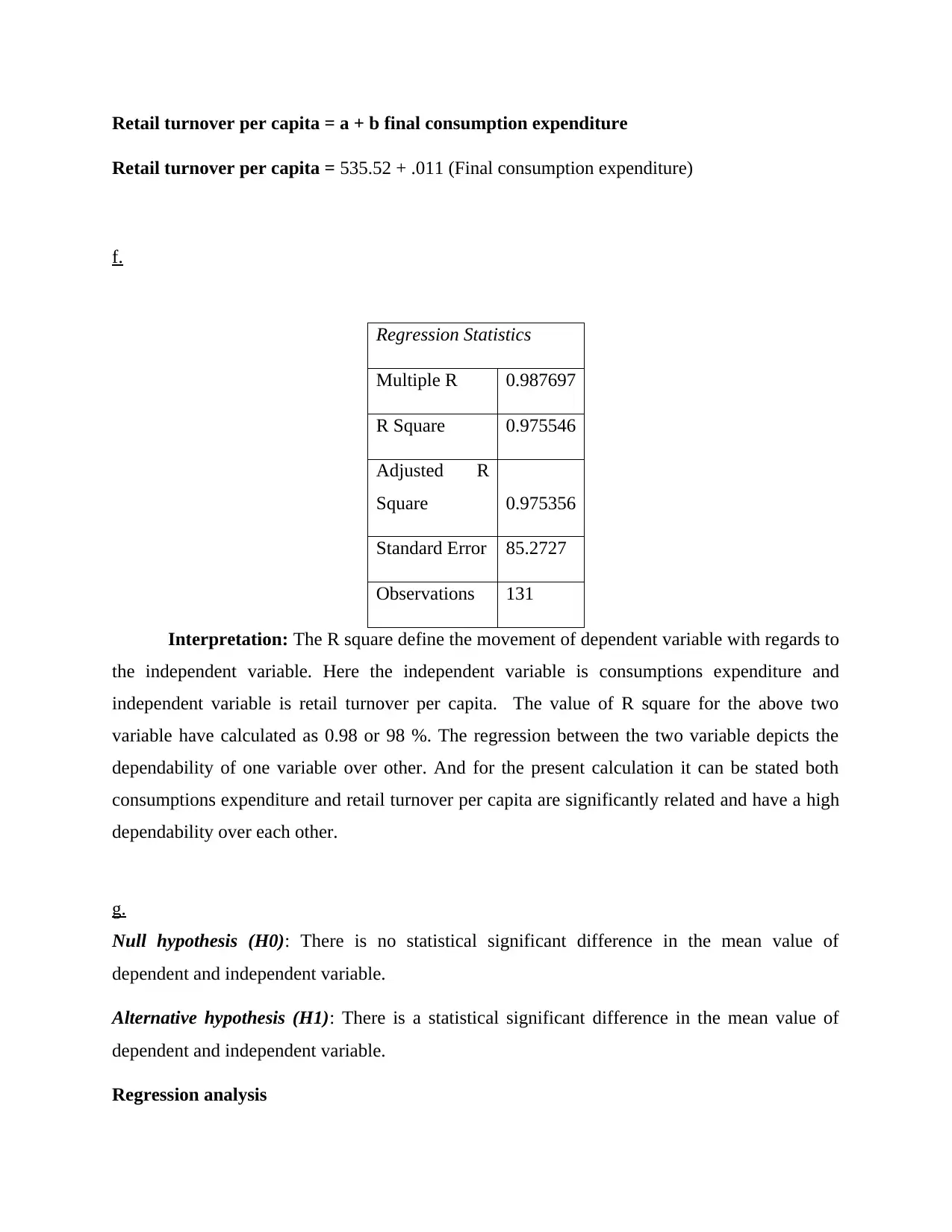
Retail turnover per capita = a + b final consumption expenditure
Retail turnover per capita = 535.52 + .011 (Final consumption expenditure)
f.
Regression Statistics
Multiple R 0.987697
R Square 0.975546
Adjusted R
Square 0.975356
Standard Error 85.2727
Observations 131
Interpretation: The R square define the movement of dependent variable with regards to
the independent variable. Here the independent variable is consumptions expenditure and
independent variable is retail turnover per capita. The value of R square for the above two
variable have calculated as 0.98 or 98 %. The regression between the two variable depicts the
dependability of one variable over other. And for the present calculation it can be stated both
consumptions expenditure and retail turnover per capita are significantly related and have a high
dependability over each other.
g.
Null hypothesis (H0): There is no statistical significant difference in the mean value of
dependent and independent variable.
Alternative hypothesis (H1): There is a statistical significant difference in the mean value of
dependent and independent variable.
Regression analysis
Retail turnover per capita = 535.52 + .011 (Final consumption expenditure)
f.
Regression Statistics
Multiple R 0.987697
R Square 0.975546
Adjusted R
Square 0.975356
Standard Error 85.2727
Observations 131
Interpretation: The R square define the movement of dependent variable with regards to
the independent variable. Here the independent variable is consumptions expenditure and
independent variable is retail turnover per capita. The value of R square for the above two
variable have calculated as 0.98 or 98 %. The regression between the two variable depicts the
dependability of one variable over other. And for the present calculation it can be stated both
consumptions expenditure and retail turnover per capita are significantly related and have a high
dependability over each other.
g.
Null hypothesis (H0): There is no statistical significant difference in the mean value of
dependent and independent variable.
Alternative hypothesis (H1): There is a statistical significant difference in the mean value of
dependent and independent variable.
Regression analysis
⊘ This is a preview!⊘
Do you want full access?
Subscribe today to unlock all pages.

Trusted by 1+ million students worldwide
1 out of 15
Related Documents
Your All-in-One AI-Powered Toolkit for Academic Success.
+13062052269
info@desklib.com
Available 24*7 on WhatsApp / Email
![[object Object]](/_next/static/media/star-bottom.7253800d.svg)
Unlock your academic potential
Copyright © 2020–2025 A2Z Services. All Rights Reserved. Developed and managed by ZUCOL.





